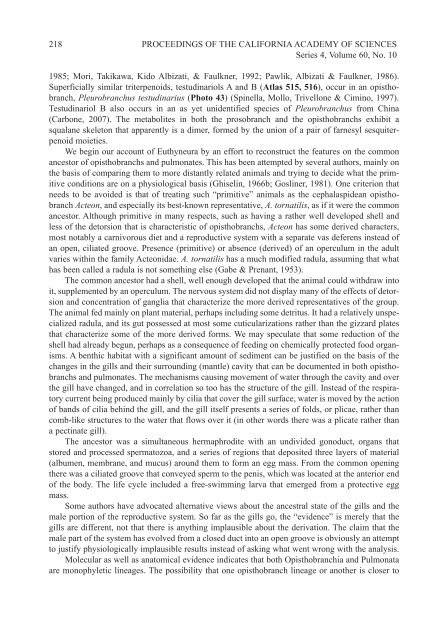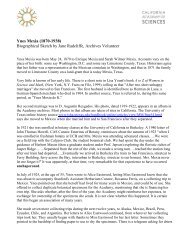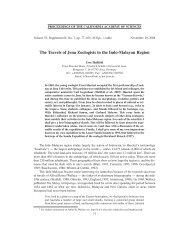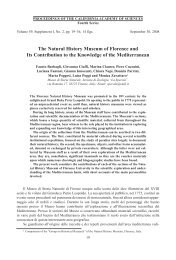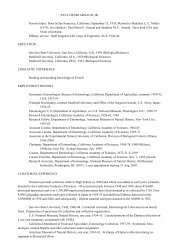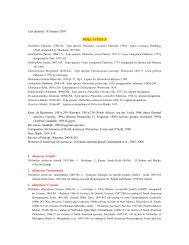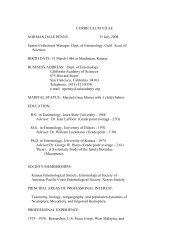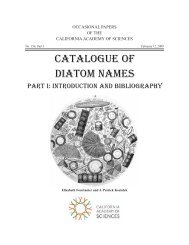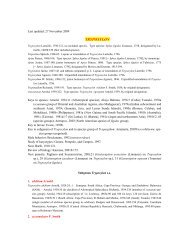Cimino&Ghiselin-tmpZXYZ:Template Proceedings_1.qxd.qxd
Cimino&Ghiselin-tmpZXYZ:Template Proceedings_1.qxd.qxd
Cimino&Ghiselin-tmpZXYZ:Template Proceedings_1.qxd.qxd
Create successful ePaper yourself
Turn your PDF publications into a flip-book with our unique Google optimized e-Paper software.
218 PROCEEDINGS OF THE CALIFORNIA ACADEMY OF SCIENCES<br />
Series 4, Volume 60, No. 10<br />
1985; Mori, Takikawa, Kido Albizati, & Faulkner, 1992; Pawlik, Albizati & Faulkner, 1986).<br />
Superficially similar triterpenoids, testudinariols A and B (Atlas 515, 516), occur in an opisthobranch,<br />
Pleurobranchus testudinarius (Photo 43) (Spinella, Mollo, Trivellone & Cimino, 1997).<br />
Testudinariol B also occurs in an as yet unidentified species of Pleurobranchus from China<br />
(Carbone, 2007). The metabolites in both the prosobranch and the opisthobranchs exhibit a<br />
squalane skeleton that apparently is a dimer, formed by the union of a pair of farnesyl sesquiterpenoid<br />
moieties.<br />
We begin our account of Euthyneura by an effort to reconstruct the features on the common<br />
ancestor of opisthobranchs and pulmonates. This has been attempted by several authors, mainly on<br />
the basis of comparing them to more distantly related animals and trying to decide what the primitive<br />
conditions are on a physiological basis (<strong>Ghiselin</strong>, 1966b; Gosliner, 1981). One criterion that<br />
needs to be avoided is that of treating such “primitive” animals as the cephalaspidean opisthobranch<br />
Acteon, and especially its best-known representative, A. tornatilis, as if it were the common<br />
ancestor. Although primitive in many respects, such as having a rather well developed shell and<br />
less of the detorsion that is characteristic of opisthobranchs, Acteon has some derived characters,<br />
most notably a carnivorous diet and a reproductive system with a separate vas deferens instead of<br />
an open, ciliated groove. Presence (primitive) or absence (derived) of an operculum in the adult<br />
varies within the family Acteonidae. A. tornatilis has a much modified radula, assuming that what<br />
has been called a radula is not something else (Gabe & Prenant, 1953).<br />
The common ancestor had a shell, well enough developed that the animal could withdraw into<br />
it, supplemented by an operculum. The nervous system did not display many of the effects of detorsion<br />
and concentration of ganglia that characterize the more derived representatives of the group.<br />
The animal fed mainly on plant material, perhaps including some detritus. It had a relatively unspecialized<br />
radula, and its gut possessed at most some cuticularizations rather than the gizzard plates<br />
that characterize some of the more derived forms. We may speculate that some reduction of the<br />
shell had already begun, perhaps as a consequence of feeding on chemically protected food organisms.<br />
A benthic habitat with a significant amount of sediment can be justified on the basis of the<br />
changes in the gills and their surrounding (mantle) cavity that can be documented in both opisthobranchs<br />
and pulmonates. The mechanisms causing movement of water through the cavity and over<br />
the gill have changed, and in correlation so too has the structure of the gill. Instead of the respiratory<br />
current being produced mainly by cilia that cover the gill surface, water is moved by the action<br />
of bands of cilia behind the gill, and the gill itself presents a series of folds, or plicae, rather than<br />
comb-like structures to the water that flows over it (in other words there was a plicate rather than<br />
a pectinate gill).<br />
The ancestor was a simultaneous hermaphrodite with an undivided gonoduct, organs that<br />
stored and processed spermatozoa, and a series of regions that deposited three layers of material<br />
(albumen, membrane, and mucus) around them to form an egg mass. From the common opening<br />
there was a ciliated groove that conveyed sperm to the penis, which was located at the anterior end<br />
of the body. The life cycle included a free-swimming larva that emerged from a protective egg<br />
mass.<br />
Some authors have advocated alternative views about the ancestral state of the gills and the<br />
male portion of the reproductive system. So far as the gills go, the “evidence” is merely that the<br />
gills are different, not that there is anything implausible about the derivation. The claim that the<br />
male part of the system has evolved from a closed duct into an open groove is obviously an attempt<br />
to justify physiologically implausible results instead of asking what went wrong with the analysis.<br />
Molecular as well as anatomical evidence indicates that both Opisthobranchia and Pulmonata<br />
are monophyletic lineages. The possibility that one opisthobranch lineage or another is closer to


